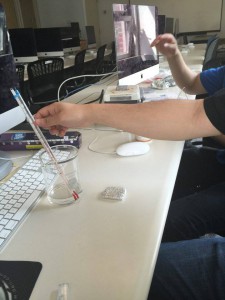Theory
Going into this experiment we wanted to explore specific heat and actually find the specific heat of objects. Initially, we found it to be interesting because knowing that information is important in aspects of everyday life. For example if you had a kitchen table or countertop, you would want a substance that has a higher specific heat because on the chance you do have to put something hot on it and you unfortunately touched it, being burned would occur with a substance that has a low specific heat. That is not the only aspect we found specific heat. It is everywhere, the material of the coat you are wearing. You would want it to have a higher specific heat as well to keep your body heat inside the cost and for it not to change when exposed to the cold weather. During one of the write ups having to think of specific heat and how it relates to sustainability, we thought of solar panels specifically and how you would want to have a material that has a low specific heat so the material can heat up quicker and you can retain more energy. Before doing the experiment we had a hypothesis that Aluminum would have a low specific heat and either Granite or Quartz would have a high one with Glass being somewhere in the middle. Now having conducted the experiment, we have found out that our hypothesis was correct. We now have a newfound respect for those who calculate specific heat as it was harder and more tenuous than it seemed. Now everywhere we look at substances, in our head we will think “ I wonder what it’s specific heat is”.
Setup
Materials include one beaker, one thermocouple, one thermometer, one mass scale, 100 mL of water, one hot plate, a pair of tongs, safety goggles, one sample of aluminum, one sample of gray granite, one sample of white quartz, and one sample of glass.
Step 1.) Put on safety goggles.
Step 2.) Make sure the thermocouple is properly configured in respect to having the unit be attached to the probe.
Step 3.) Measure the respected mass of the solid material in kilograms. Observe and record.
Step 4.) Fill up the beaker with 100 mL of water at room temperature.
Step 5.) Measure the initial temperature of the water in the beaker in degrees celsius. Observe and record.
Step 6.) Heat the respected material on a hot plate on medium to high heat.
Step 7.) Measure the temperature of the mass by utilizing a thermocouple by turning the dial to degrees celsius and waiting until it reaches 72 Degrees Celsius.
Step 8.) Transfer the respected material by utilizing a tong from the hot plate to the beaker of water by lightly placing it into the beaker of 100mL of water.
Step 9.) Place the thermometer into the Beaker, and wait until the temperature of the water peaks, indicating a temperature equilibrium between the material and the water. Observe and record. The reason why this is an essential step because knowing the specific heat of water is 1 kcal/kg ℃, one can know the amount of heat energy absorbed within the water thus determining the specific heat of the object.
Data Collection:
Step 10.) Subtract the final temperature of the water by the initial temperature and divide by 10. EX: 3 degrees change → .3 kcal due to the constant of 100 grams or .1 kilograms of water being utilized.
Measuring Specific Heat:
Step 11.) Calculate the specific heat.
Specific Heat → (Amount of heat to change temperature (Measured in Calories)) / (Mass x Change in temperature)

Results
The following video can help you visualize what specific heat means, and put the following results into perspective: https://youtu.be/eIBVimdYnDI
Specific Heat (kcal/kg-C)
Aluminum: 0.0983
White Quartz: 0.2237
Gray Granite 0.2899
Glass: 0.1522
Aluminum- At less than one tenth of the specific heat of water, aluminum has the smallest specific heat from the sample materials. This is a property in accordance with its domestic uses in cooking. It is an efficient heat transfer material.
White Quartz- This material ranks as the second highest specific heat value. It is significantly higher than aluminum or glass, making it suitable for use as a household countertop, but is still lower than Gray Granite. After much heating and cooling, a white quartz counter may not prove to be very durable.
Gray Granite- With a specific heat of almost three tenths that of water, gray granite has the highest specific heat of the materials by a significant margin. This means it has a large heat capacity, and requires a relatively large amount for heat energy to raise its temperature. This makes it the most suitable for a countertop, because it could withstand the high temperatures of hot pots and pans, and would most likely last longer than other materials. It would also reduce the risk of burns, with a less drastic temperature increase. This may be part of the reason why granite is such a widely used material for countertops.
Glass- This material lies in the middle of the scale of specific heats, and I would guess it is because as a material, domestic glass uses have less relevance to specific heat. Usually used for drinking mildly hot or cold beverages, there is no reason for glass to have a low or high specific heat to serve its purpose.
As the specific heat characteristics of these materials are applied to their domestic uses, the specific heats of all elements are very important factors in chemistry. The hyperlink below allows you to see the specific heats of all elements in the periodic table, and illustrates the relationship between the atomic weight of an element and its specific heat value.
http://www.periodictable.com/Properties/A/SpecificHeat.html












